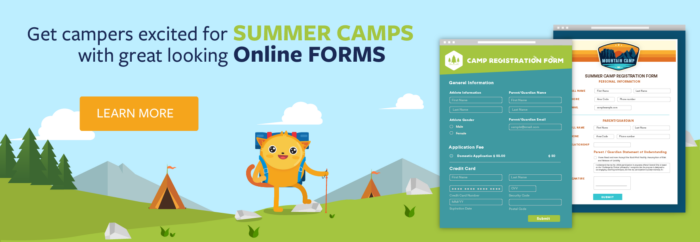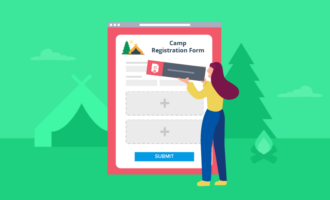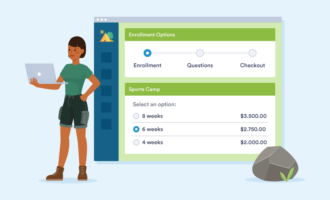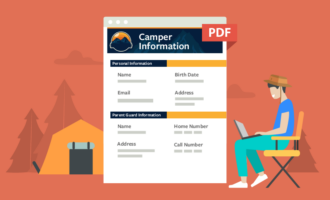Summer camps, whether coding day camps or overnight soccer camps, are big business. In fact, the American Camp Association says camps are an $18 billion industry. And a key part of running any business is managing the finances.
Camps cost money to operate. If you end up spending more than you take in, you may not be able to complete all of your camp activities. Or, worse, you may not be able to offer the camp again because it isn’t sustainable.
Successfully managing the finances for a summer camp entails tracking money and data before registration, through the camp session, and after it ends. While balancing budgets may seem daunting, a combination of basic financial management practices and helpful software allows just about anyone to manage a camp’s finances.
Pro Tip
Collect all the information you need using Jotform’s free online summer camp forms. Collect camper information, payments, files, and more!
Start by creating a budget
Every camp, no matter how large or small, needs a budget. This is the only way to know how much money is coming in, how much money is going out and whether any adjustments need to be made.
In basic budgeting, you need to know your income and expenses. Calculating your income for summer camp is relatively simple. You know how much you’ll charge for your camp, and you know how many students you can take. For most camps, the registration fee is the only source of income, so it’s easy to estimate how much money your camp will take in.
Some camps, however, get funds from state subsidies, fundraising, and grants, which must be taken into consideration. The sample budget by Arkansas’ Better Beginnings program provides a good overview and explains how to account for various budget categories.
The more complicated part is planning your expenses. This requires you to focus on the details and have a plan in place for all aspects of camp, including activities, food, staff compensation, and supplies. Finance, business, and entrepreneurship writer Meredith Turits advises businesses to plan for three different types of expenses: fixed costs, variable expenses, and contingency plans.
For a summer camp, fixed costs are items such as counselor and staff compensation, supplies, food, rent, and any insurance you need to carry. The University of Vermont’s Agritourism Department also lists asset depreciation, first aid supplies, and signage as fixed costs to consider in a summer camp budget. Of course, these vary depending on the theme of a summer camp, but most camps include similar fixed expenses.
Variable costs differ more widely between camps. These are costs that may change but should be allotted for in a budget. For example, utilities are a variable expense. The cost of utilities depends on use but can be estimated. Discretionary spending, like field trips, is also rolled in here. These types of expenses may fluctuate, but you should be able to create a good estimate of them before camp begins.
And, last but not least, always plan for the unexpected. Set up a contingency fund to help cover unplanned expenses.
All of this may seem simple enough, but it can be difficult when it comes to putting pen to paper. So don’t. Employ software to help you keep tabs on money coming in and money going out.
Use digital platforms to help track finances
Keeping tabs on the finances of a summer camp can be quite time-consuming, which is why you should consider using digital tools to help you manage the money. Whether hosting one camp for a week or several camps over many weeks, there is a solution available to take the pain out of tracking camp money.
One of the most commonly used free personal budgeting tools that can be used for summer camp is Intuit’s Mint. As financial writer Ruth Lyons asserts, “Mint keeps an eye on your money so you don’t have to.” The tool is accessible via your browser or as an app, so it is available to you wherever you are. It has some functions that may not apply to summer camp, but the basic operations are perfect for simple budget maintenance.
ZipBooks is a free accounting software tool that is great for small businesses. Marketing consultant Thomas Hanks, former growth engineering executive of ZipBooks, claims the software is so user-friendly that even someone who knows nothing about accounting can use it. Again, it can do way more than you may need for camp, but it can also meet your demands for basic budgeting.
If the thought of investing time to learn these programs doesn’t appeal to you, you can always use a basic spreadsheet to manage simple budgeting. Google Sheets is a great tool that has a template for simple budgeting. You will have to spend more time entering information than with the other tools, but it may require less of a learning curve and time investment than the others.
Speaking of digital platforms, Jotform is one tool that can help you keep track of all your registrations, payments and essentially keep you organized throughout the whole camp process. With many form templates including summer camp registration forms and the helpful integrations, Jotform offers a great chance to lower the management expenses on your budget.
Though managing a camp’s budget may not sound like fun, it is a necessity because, at their core, camps are businesses. And a camp that runs well as a business is usually effective at delivering its mission to campers, writes Daniel Zenkel, managing principal at The Camp Professionals.


































Send Comment: